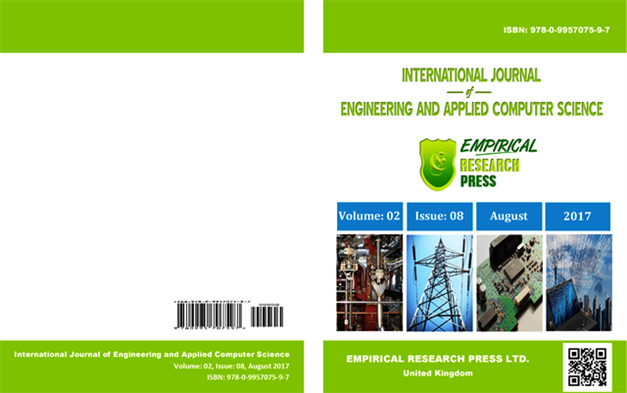



Volume: 02, Issue: 08, August 2017

Content

h-index
6
Avinash Ray, Anjali Potnis, Prashant Dwivedy, Shahbaz Soofi

i10-index
4

Impact Factor
A. Ray, “An Advance Approach of Image Encryption using AES, Genetic Algorithm and RSA Algorithm,” International Journal of Engineering and Applied Computer Science, vol. 02, no. 08, pp. 245–249, Sep. 2017. http://dx.doi.org/10.24032/ijeacs/0208/01
2.35
Abstract—In current scenario the entire world is moving towards digital communication for fast and better communication. But in this a problem rises with security i.e. when we have to store information (either data or image) at any casual location or transmit information through internet. As internet is an open transmission medium, security of data becomes very important. To defend our information from piracy or from hacking we use a technique and i.e. known as Encryption Technique. In this paper, we use image as information and use an advance approach of well-known encryption techniques like AES, Genetic Algorithm, and RSA algorithm to encrypt it and keep our information safe from hackers or intruders making it highly difficult and time consuming to decipher the image without using the key.

Mallikarjun Mudda, Bandi Madhu Sowmya, P Lalitha Ram sai, Alluri Uday
Veena, Tadikamalla sai vikas
Veena, Tadikamalla sai vikas


M. Mudda, “Energy Management with Disaster Intimation and Control using IoT,” International Journal of Engineering and Applied Computer Science, vol. 02, no. 08, pp. 250–254, Sep. 2017. http://dx.doi.org/10.24032/ijeacs/0208/02
Abstract—In the area of digitization and automation, the life of human being is getting simpler as almost everything is automated. Nowadays humans have made internet an integral part of their everyday life without which they are helpless. Internet of things (IoT) gives a platform which allows different devices to inter-connect, sense and control the things remotely across a network infrastructure without any limitation to the coverage area. In our proposed work, we stress on Wireless-Home-Automation-System (WHAS) using IoT, it is a system uses computers or smart phone to control basic home functions and features automatically through internet from anywhere around the world, an automated home is sometimes called a smart home. The proposed system is able to monitor the entire things connected to the internet and also to be maintaining the status of individual devices for further action. We have built the home automation with several devices and sensors, here sensor help to monitor the device status and intimate the authorized person to take particular action.

A. K. Singh


A. K. Singh, “Kinetics and Solvent Effect on Hydrolysis of Ethyl Cinnamate in Water-Methanol Mixture,” International Journal of Engineering and Applied Computer Science, vol. 02, no. 08, pp. 255–258, Sep. 2017. http://dx.doi.org/10.24032/ijeacs/0208/03
Abstract—The solvent effect of aquo-dipolar protic solvent system was highlighted by studying the kinetics of base catalyzed solvolysis of ethyl cinnanmate in water-methanol media of various compositions having 20 to 70% (v/v)of ethanol at different five temp ranging from 20 to 400C. Fast decrease of specific rate constant with gradual addition of organic co solvent in the reaction media and also with increasing temperature of the reaction has been explained in light of solvation in initial and transition state to different extent. The change in Iso-composition Activation energy (EC) and Iso-dielectic Activation energy (ED) also explained the solvation and desolvation of initial and transition states to different extent The decrease in number of water molecule (1.59 to 1.42) associated with the activated
complex is found to be decrease in water-MEOH system and this tells about the fact that in presence of MEOH the mechanistic path of reaction is change from bio-molecular to uni-molecular. Increase in numerical value of free energy of activation (G*) simultaneous decrease in entropy of activation (S*) and enthalpy of activation (H*), of reaction media reveals that ethanol acts as entropy inhibitor and Enthalpy stimulator.
complex is found to be decrease in water-MEOH system and this tells about the fact that in presence of MEOH the mechanistic path of reaction is change from bio-molecular to uni-molecular. Increase in numerical value of free energy of activation (G*) simultaneous decrease in entropy of activation (S*) and enthalpy of activation (H*), of reaction media reveals that ethanol acts as entropy inhibitor and Enthalpy stimulator.

Shahbaz Soofi, Anjali Potnis, Prashant Dwivedy


S. Soofi, “Heterogeneous Spectrum Sensing in Cognitive Radio Network using Traditional Energy Detection and Matched Filter,” International Journal of Engineering and Applied Computer Science, vol. 02, no. 08, pp. 259–263, Sep. 2017. http://dx.doi.org/10.24032/ijeacs/0208/04
Abstract—The accurate spectrum sensing is a predominant aspect of any competent CR system. Efficient spectrum sensing enables a CR terminal to detect the spectrum holes (underutilized spectral bands) by providing high spectral resolution, thereby accrediting opportunistic transmission in the licensed band to the CR. In order to facilitate a good spectrum management and its efficient use a hybrid method for the detection of the spectrum with the purpose of detecting the presence of bands of unoccupied frequencies is proposed. The method used are traditional energy detection and matched filter with changing number of secondary users using each technique and finally a centralized cooperative spectrum sensing network which employs hard combination at the fusion centre.

A.K. Singh


A. K. Singh, “Studies of Solvent Effect of Aquo-Methanol Solvent System on Kinetics and Activation Parameters of Base Catalised Hydrolysis of Ethyl Cinnamate,” International Journal of Engineering and Applied Computer Science, vol. 02, no. 08, pp. 264–266, Sep. 2017. http://dx.doi.org/10.24032/ijeacs/0208/05
Abstract—The rate of alkaline hydrolysis of ethyl cinamate was measured over the temperature range of 20o C to 40 o C in watermethanol mixture at different composition 30 to 70% (v/v).The specific rate constant was calculated using second order reaction. The influence of solvent variation on reaction rate was examined in term of changes in the Activation parameter. Depletion of H* and S* value with simultaneous increase in G* of the reaction in media, reveals that the reaction is Enthalpy domination and Entropy controlled. The Values of Iso-kinetic which is less than 300, clearly indicates that there is no appreciable interaction between solvent and solute present in the reaction media, i.e. reaction is not ion-dipole but ion-molecule type.

Ali Salem Ali Bin Sama, Saeed Mohammed Saeed Baneamoon


A. S. A. Bin Sama and S. M. S. Baneamoon, “Breast Cancer Classification Enhancement Based on Entropy Method,” International Journal of Engineering and Applied Computer Science, vol. 02, no. 08, pp. 267–271, Sep. 2017. http://dx.doi.org/10.24032/ijeacs/0208/06
Abstract—Breast cancer is the most common form of cancer diseases among women and the second leading cause of cancer deaths worldwide. However, due to some limitations in mammography, it is difficult to classify a suspicious mass in the breast as malignant (cancerous) or benign. This paper attempts to classify the mammographic masses with high accuracy by combining entropy method with evolutionary algorithm (EA) and fuzzy logic. EA and fuzzy logic are applied at training phase for parameters tuning, however, entropy method is applied at training phase and localization phase, where at training phase entropy enhances indicator of fuzziness, while at mass phase entropy enhances EA for the classification of masses in mammogram images. The proposed method is evaluated by experimenting a number of the benchmark Mini-MIAS databases and the results shows better and more effective identification.










